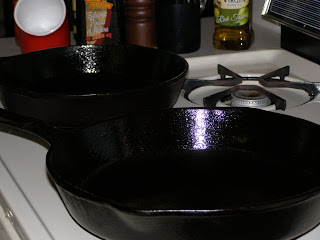Congratulations! You have just purchased your new cast iron skillet and you get home and start thinking about making some cornbread in it. Wait, not so fast my friend. First you need to prepare your skillet so that it will cook properly and last for a long time.
Cast iron has a porous surface that needs to be seasoned. Seasoning fills in the porous holes with fat and smoothes out the surface. Your new pan will be a steely grey color and it not ready for cooking. A properly seasoned well used pan will be black as coal and have a smooth non-stick surface. With a properly seasoned pan you can cook anything from fried chicken and cornbread to pineapple upside-down cake.

To season a new pan you will first need to clean it thoroughly, as they will have a coating on them from the manufacturing process. Scrub the new pan with hot soapy water and a stiff brush to remove the coating. Hopefully this will be the last time soap will touch the pan. WHAT? How the heck do you clean the thing with no soap? We’ll get to that in a bit. For now let’s get your pan seasoned. Coat the pan with a light coating of Crisco and place upside down in a pre-heated 250F oven for 1 hour. Place a sheet of aluminum foil under the pan to catch the drippings. After an hour turn off the oven and let it cool to room temperature. Repeat this procedure at least one more time. Finish by coating the inside of the pan with a light coating of oil.
You are now ready to cook friend! Just not the cornbread you were hoping for. The first several times use the pan to cook high fat content foods like bacon or hamburgers. Season your pan a few more times during these early uses and you will notice the pan getting darker and the cooking surface smoother. Do not cook acidic foods like tomatoes during this early cooking as the acid will degrade the season surface and you will have to start over. Once the pan is properly seasoned you can use it to cook anything you like.
Cleaning the iron skillet is perhaps the hardest part for the neophyte to wrap their head around. You should never use soap. After the pan cools, rinse and wipe with paper towels until no more reside appears on the paper towels. You can also use a soft bristle nylon brush. For tougher cleanup jobs use a soft nylon brush and coarse sea salt. Rinse and dry thoroughly then coat lightly with oil. Don’t coat with oil if you don’t plan on using the pan for a while as the oil will turn rancid. When properly maintained this way a cast iron skillet can last for generations.
Occasionally a pan will need to be re-seasoned because of buildup that degrades the non-stick surface. To do this you will need to scrub the pan with hot soapy water and a stiff brush or scouring pad. I guess I lied about no soap. After this cleaning you will need to repeat the seasoning process a couple of times. If a pan gets really bad you may need to remove all of the seasoning and start over as it were a new pan. To do this, place the pan either in a fireplace or larger grill where the hot coals have died down a bit to ash grey. Move the skillet around with a poker to prevent it from cracking. After the seasoning has been removed, cool and clean thoroughly. Now season the pan as if it were a new pan.
Happy cooking with your new cast iron skillet!
P.S. Here's some great info from CoastRanger
Good advice about the care of cast iron except for the toss it into the fire to burn off the crud part, too hot for a nice old pan. Leaving it in an electric oven for the clean cycle is not much better.
Soak it in a five-gallon bucket of water to which you have added lye. Leave it for a week and then check it. You can leave it in lye water for weeks. Eventually all the carbon will dissolve and you can use the lye water repeatedly.
Now wash off the pan and go through your seasoning steps.
CoastRanger
2 comments:
Nice blog!
Good advice about the care of cast iron except for the toss it into the fire to burn off the crud part, too hot for a nice old pan. Leaving it in an electric oven for the clean cycle is not much better.
Soak it in a five-gallon bucket of water to which you have added lye. Leave it for a week and then check it. You can leave it in lye water for weeks. Eventually all the carbon will dissolve and you can use the lye water repeatedly.
Now wash off the pan and go through your seasoning steps.
John
CoastRanger
Thanks for the tip CoastRanger. I'll amend my blog with it.
Zank
Post a Comment